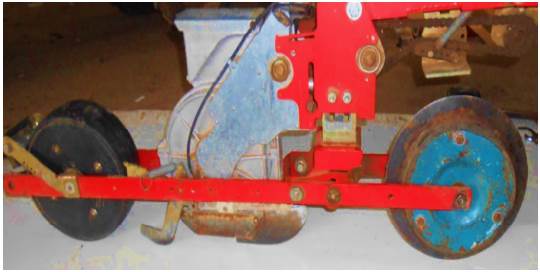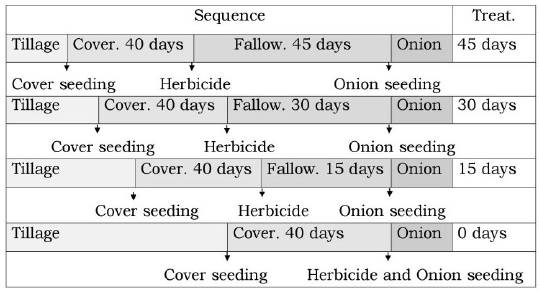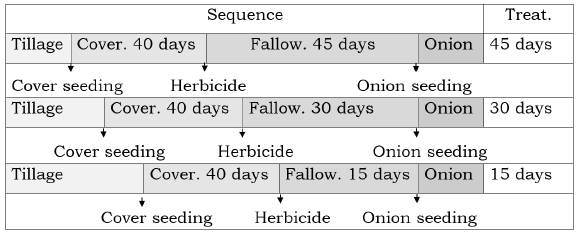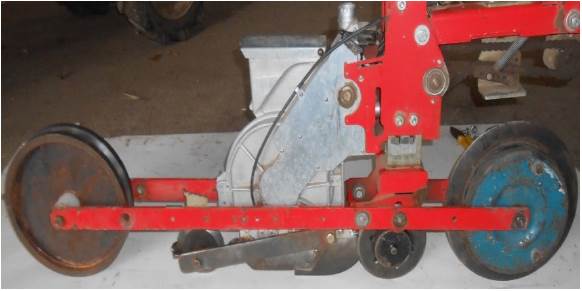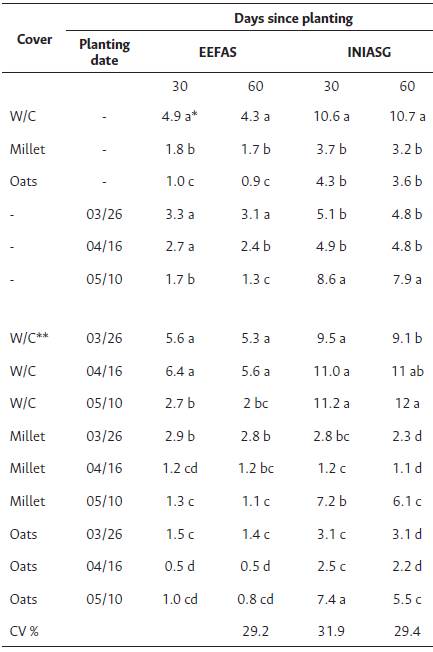Introduction
The planting of vegetables on uncovered soils causes some undesirable effects on the soil and the development of the crops on them. According to McIntyre (1958), the impact of raindrops on the soil causes a physical destruction of the surface aggregates and a redistribution of the disaggregated particles, filling holes and pores, forming a superficial crust. The superficial crust or crusting produces a reduction in the establishment of crops (Holder & Brown, 1974).
In northern Uruguay, relatively concentrated precipitation occurs in late summer and autumn (February to April), with high-intensity rainfall (Bettolli et al., 2010) when the onion crops are usually planted. Crops are frequently exposed to favourable conditions for crusting during its establishment.
According to Brunel et al. (2013), covering the soil with stubble reduce soil crusting and erosion because these cushions the impact of the raindrops.
Cover crops can affect weed development by allelopathic effects. According to Willis (2007), the term allelopathy was introduced and described by Hans Molisch in the year 1937 as a science that studies biochemical interactions between plants that can stimulate or inhibit plant development. Allelopathy is reported as a useful mechanism for weed control, but it is also a mechanism that affects crops of interest. Della Penna et al. (2009) evaluated the allelopathic effect of sow thistle (Sonchus oleraceus L.) on root germination and elongation of green onion (Allium schoenoprasum L.) and chicory (Cichorium intybus L.) by a germination test in solutions with different concentrations of aqueous extracts of the aerial part of the sow thistle. They obtained a decrease of germination and root elongation, and this decrease was greater at higher concentrations. In this work, evaluation of an alternative system of onion production, which consists of direct sowing on a soil with a cover crop chemically controlled prior to sowing, was proposed. Because direct-sowing of onions is not performed in north-western Uruguay, three planting dates were included in the search for the one most suitable for the area and for the selected cover crops.
The objectives of the study were to evaluate the effect of different cover crops and the length of the chemical fallow on direct seeding onion crops.
Materials and methods
The work was carried out in three consecutive years: 2013, 2014, and 2015.
Trials carried out in 2013
In 2013, similar essays were performed in experimental stations of the Faculty of Agriculture (EEFAS) and INIA Salto Grande (INIASG), with oats (Avena sativa L.) and millet (Setaria itálica (L.) P. Beauv.) being evaluated as cover crops at three sowing dates. At the first site, the soil has a sandy loam texture, and at the second, it is a clay loam soil.
Soil tillage was carried out beginning in December of 2012, with primary and secondary tillage with bed shaping being conducted. In the trial, nine treatments consisting of the combination of three soil management and three planting dates were performed. Soil management included conventional direct seeding on soil without cover (W/C), direct sowing on oat cover (oats), and direct sowing on millet cover (millet). The onion planting dates were March 26, April 16, and May 10.
For each planting date, the soil was conditioned and cover was immediately sowed. The cover was chemically controlled after 40 days of growth and onion was planted after 20 days of chemical fallow. For the treatments without cover, only conditioning of the soil and planting of the onion crop were performed. The sequence is illustrated in Figure 1.
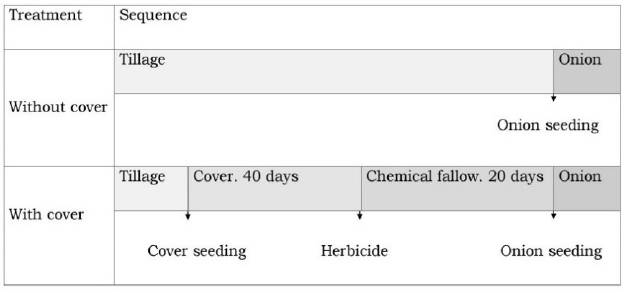
Figure 1 GraphicaL representation of the sequence of activities performed to estabLish the crop in 2013
The sowing of the cover crop was done manually. The seed density was 400 kg ha-1 for oats and 40 kg ha-1 for millet. The herbicide used to control the cover crop was Range NF (glyphosate 360 g L-1, Cibeles), at a rate of 5 L ha-1.
Seeding of the onion crop was carried out with a precision planter with a pneumatic vacuum meter (model SNC, Agrícola Italiana Massanzago, Padua, Italy). It consists of a rubber-lined front wheel (0.08 m wide and 0.24 m in diameter), a furrow- opening shoe, a furrow-closing wheel and a rear wheel with the same characteristics as the front wheel. This planter frame is suitable for sowing on tilled soil. As the trials were carried out on cover crops and the same type of furrow should be opened, the rubber wheel, which was placed in front of the planter frame, was replaced by a wheel of the same diameter but with a smooth circular blade, with the objective of cutting stubble in the area of action of the furrow openers (Figure 2).
The cultivar of onion used was INIA Casera. In that year, the available seed for that variety had a low germination percentage (58 %), but it was used because it is the most important variety in the area. It was planted in beds of four rows at a spacing of 1.6 m between beds and 4.4 cm between seeds, which gave a theoretical stand of 569.500 seeds per hectare.
The crop was fertilized based on the soil analysis of each site. Base fertilization was performed prior to planting the cover crop, with a fertilizer with an NPK content of 7-40-0 at EEFAS and 18-46-0 at INIA being applied. The crop was subsequently re-fertilized with urea 30 days after sowing.
Weed control at both sites and for each planting date consisted of the application of the pre-emergent herbicide Weedox (Pendimetalin 330 g L-1, Saudu). The doses at EEFAS and INIASG were 2 and 1 L ha-1, respectively, because the soils had different organic matter contents. No disease control was required during the evaluation period.
The experimental design was randomized complete blocks with factorial arrangements of treatments and four replicates. The two factors were soil management, with three levels, and date of sowing, with three levels. Each plot consisted of a bed with four rows of onions, with 20 m long rows at INIASG and 15 m long rows at EEFAS. The variables studied were the dry matter production of the cover crops and the establishment of the onion crop at 30 and 60 days.
Field trials in 2014 and 2015
In 2014 and 2015, trials were conducted at EEFAS. The effect of the length of the chemical fallow of oats on the establishment of the onion was evaluated.
The process of establishing the onion crop on a cover was like that used in 2013. The same sequence was used, with the growth period of the cover crop (40 days) being maintained but with the fallow duration being varied. In these trials, only the oat crop was used as cover, and the onion crop was planted on a single date. Soil tillage began in January, with both primary tillage and secondary tillage being performed.
In 2014, four treatments and one control without cover (W/C) were used; fallow lenght was 0, 15, 30, and 45 days. In the year 2015, the fallow duration periods evaluated were 15, 30, and 45 days. The sequence for the treatments carried in 2014 and 2015 are shown in Figure 3 and 4 respectively.
Sowing of the cover crop was done manually. Seed density was 500 kg ha-1 and it was controlled with the same herbicide used in 2013.
Seeding of the onion crop was carried out with the same planter used in 2013. In 2013, planting difficulties occurred when the system accumulated crop residue in front of the furrow opener, making it necessary to stop sowing to remove the stubble. Because of that, modifications were made to the planter frame: to avoid the accumulation of stubble in front of the original shoe, a double disk furrow opener was added, and behind that, a wheel was added to press the seed into the bottom of the furrow. The rear rubber wheel was replaced by an iron wheel (Figure 5).
The onion cultivar INIA Casera was again used. In 2014, the percentage of germination for this variety was 75 %, and in 2015, it was 84 %. The planting framework and planting density was identical to that used in 2013.
The crop was fertilized based on soil analysis. Base fertilization with an 18-46-0 fertilizer was conducted before planting the cover crop, and the crop was subsequently re-fertilized with urea at 30 days after planting. For weed control, in 2014, the pre-emergent herbicide Weedox was applied at a rate of 2 L ha-1 on the day after sowing and following sprinkler irrigation. In 2015, the herbicide Prodigio (Aclonifen 600 g L-1, Bayer) was applied 30 days after sowing. Disease control was not necessary in either of the two study years.
The experimental design was complete random blocks with four replicates. In 2014, five treatments were used; in 2015, four. Each plot consisted of a bed with four rows of onion with a length of 12 m. The evaluations for all the variables were carried out on the central 8 m of the plots. The variables studied were the dry matter production of the cover and the establishment of the onion crop at 30 and 60 days after planting.
Laboratory trial in 2015
In 2015, in addition to the field trial, an experiment was carried out to evalúate the germination of onion seeds in the laboratory, with solutions obtained from the crop residue of the field trial. The work was carried out in the phytopathology laboratory at EEFAS.
For this, the aerial cover residues from the field trial were extracted from an area of 0.09 m2 in each plot. Samples were placed in an oven at 60 °C for 4 hours for to extract free water. They were then placed in trays with distilled water (0.02 L of water per gram of dry matter in the sample). At 24 hours, the water of each tray was filtered allowing water without crop residue to be obtained but also allowing the substances released by this residue to be collected. A Petri dish was prepared per plot, where 0.03 L of the extract obtained from each tray was added. On each plate, 30 onion seeds were germinated on filter paper. The plates were maintained at 25 °C. Only distilled water was added to the control treatment. This method was adapted from that suggested by Ferreira and Reinhard (2011). The seed used belonged to the same lot that was planted in the field. Germination was evaluated at 7 and 14 days; radicle elongation, at 14 days.
Statistical analysis
Statistical analysis was performed using the GLM procedure of SAS software (Version 9.0). The univariate procedure was applied to verify the normality of the data. The variables that did not have normal distribution were transformed by the function log or the function V"Y + 0.5. The comparison of means was performed using the Tukey-Kramer test. Differences between means with a probability of type I error higher than 5 % were not considered significant.
Results
Year 2013
Dry matter production of cover crops:
The dry matter yield of the cover crops varied according to the planting day. Lower dry matter yield was observed on the first date for the two cover crops and at the two experimental sites (Table 1).
Table 1 Dry matter content in kg ha-1 of the cover crops at the time of herbicide application in 2013
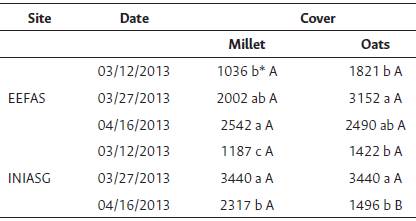
*Means of each site in columns and rows followed by lowercase and uppercase letters, respectively, do not differ significantly (prob. F < 0.05).
Regarding the species, no differences were observed at EEFAS. At INIASG, differences were observed between the two species used as covers only when sowed on 04/16, where millet experienced the highest production.
Plant establishment
Significant differences in establishment were observed between treatments with different covers, sowing dates, and in the interaction between both factors in the two evaluation moments.
Regarding the main effects, at both sites, sowing without cover had the highest plant density (Table 2). At INIASG, no differences were observed between the cover crops used. In contrast, at EEFAS, the establishment obtained with oats was lower than that obtained with millet. An interaction with sowing date was observed; in all cases, the highest values of establishment were obtained with the earliest planting date at EEFAS and with the latest date at INIASG.
Years 2014 and 2015
Dry matter of the cover
In 2014, no significant differences in dry matter were observed between the different treatments. In 2015, the treatment with shorter fallow length produced more dry matter than the longest one (Table 3).
Table 3 Dry matter at the time of herbicide appLication in 2014 and 2015.
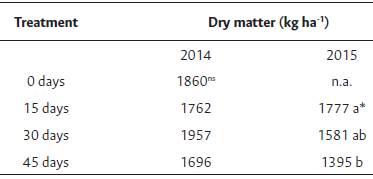
*Within columns, means by the same letter are not significantly different according to Tukey's test (P > 0.05). ns: No statistically significant differences. n.a.: not applicable.
Establishment
In 2014, onion establishment evaluated at 30 days was lower in the treatments with 0 and 15 days of fallow, with the highest values of establishment being obtained for the treatments of 45 days of fallow and for the control (Table 4). The establishment evaluated at 60 days did not present statistically significant differences between treatments, despite the occurrence of important differences in absolute terms.
Table 4 Establishment of the onion crop (number of plants per metre of furrow) in 2014 and 2015
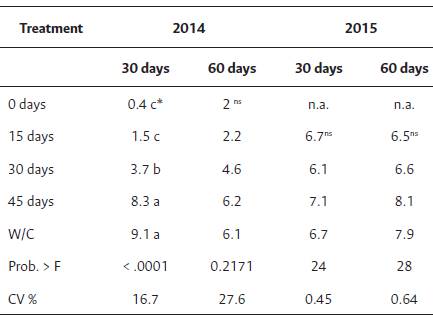
*Within columns, means by the same letter are not significantly different according to Tukey's test (P > 0.05). ns: No statistically significant differences. n.a.: not applicable.
In 2015, no differences were observed in the establishment of onion crops between treatments.
Laboratory trial 2015
In the laboratory trial, effects of fallow duration on seed germination were observed but not on radicle length (Table 5).
Table 5 Number of seeds over 30 per plate germinated, and the length of the radicle en cm
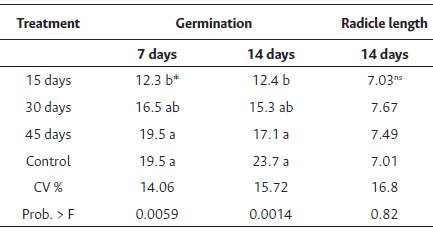
*Within columns, means by the same letter are not significantly different according to Tukey's test (P > 0.05). ns: No statistically significant differences.
The lowest germination values were obtained with the shortest duration of chemical fallow. No difference was observed between the crop cover for fallow duration treatment of 45 days and the control treatment.
The radicle length obtained was similar for the different chemical fallow lengths and the control treatment.
Discussion
In 2013, onion establishment was greater in the treatments without cover contrarily to Cogo et al. (1984), who observed that in soils without cover the plant establishment could diminish due to soil crusting. Chauhan et al. (2012) mention the effects of weed control by the presence of cover. This control may be due to changes in the conditions under the cover crop, which may cause the seeds of weedy species to remain dormant. Because weeds release allelopathic substances and act as a physical barrier to the emergence of seedlings, any inhibition of weeds will favor the establishment of the desired crop. This latter effect could explain the greater establishment of onion obtained in the treatment without cover.
Although differences occurred between the treatments, with uncovered soils performing the best, in all cases, the percentage of establishment was low. Not a single treatment surpassed an establishment of 50 %, even though 22 seeds m-1 were sown. Part of this can be explained by the fact that a significant percentage of the seed sown did not germinate, which is reflected by the low germination percentage (58 %).
When the dry matter production of the covers is observed and compared to crop establishment, at EEFAS, the greatest establishment was observed at the earliest date (March 26), coinciding with the lowest production of dry matter. However, at INIASG on the same date, the lowest establishment coincided with lowest production of dry matter. Therefore, no clear relation between dry matter weight and plant establishment can be observed in these trials.
In 2014, establishment improved as the fallow duration increased. These differences were obtained although the dry matter production was similar (Table 3). Because the main difference between treatments was the duration of the chemical fallow, when the fallow was short, a decrease was observed in the establishment, and a clear relation between fallow duration and plant density was observed: the longer the chemical fallow, the higher the plant density.
According to Moraes et al. (2011) the suppression of weed growth by a cover crop may be to the release of allelopathic substances. In this case, the cover crop could be releasing allelopathic substances that negatively affect the establishment of onion. Ducca and da Costa (2008), studying the effect of oat extracts, observed that this crop has an allelopathic effect on the soybean crop, an effect that disappears as the time since oat death lengthens. The same effect was observed in this experiment on onion cultivation: the longer the fallow period, the greater their establishment. In 2013, onion was planted 20 days after the cover was controlled. With this fallow duration, very low establishment values were obtained. Examining the results for the year 2014, 20 days of fallow is a short time, and this may be the factor that explained the low establishment obtained compared to the treatment without cover in 2013.
In 2015, however, no differences were observed in the establishment in the field. The difference between 2014 and 2015 could be explained by a rain event recorded after sowing. In 2015, onion was sown on April 30, and on May 2, 90 mm of rainfall were recorded, and eight days later, 20 mm of rainfall were recorded (Figure 6). In 2014, the rainfall regime was different; seven days after sowing, 21 mm of rainfall were recorded, and 11 days later, 9.2 mm were recorded(Figure 7). The high rainfall recorded in 2015 may have led to a reduction in the concentration of allelopathic substances in the soil by leaching, as observed in the trials performed by Della Penna et al. (2009) and Silva et al. (2016), where, as the concentration of plant extracts was lowered, the germination was higher. According to Qasem (2001), intense rain events under field conditions may cause the leaching of allelopathic substances, which could explain why no differences were observed between treatments with different chemical fallow duration in the 2015 field trial.
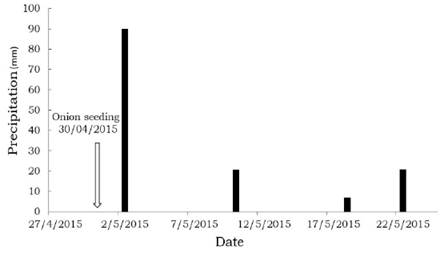
Figure 6 Precipitation during onion establishment in 2015. Data obtained from EEFAS Meteorological Station.
In the 2015 laboratory trial, germination reduction was observed when the fallow duration was increased (Table 5). This result shows that germination was affected by the duration of chemical fallow, and this effect is probably due to the release of substances that inhibited germination.
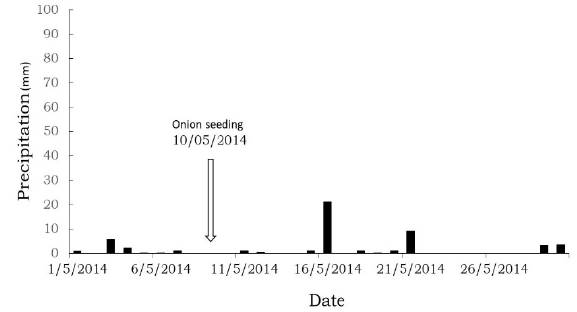
Figure 7 Precipitation during onion establishment in 2014. Data obtained from EEFAS Meteorological Station.
Because this trial was performed in the laboratory and the only factor that varied between plots was the origin of the extract where the onion seeds germinated, possibly, the substances released by the cover crop are the ones that conditioned the germination. Based on the definition of allelopathy introduced by Hans Molisch in 1937, an allelopathic effect would explain these results. The cover that had the longest fallow duration was not different from the control, suggesting that the effect of inhibited germination was diminishing as the time of fallow increased.
As for the results observed in the field in 2015, possibly, this effect is not expressed in the same way as in the laboratory because other factors are at play. According to Duke (2010), other factors can influence germination, such as the concentration of chemicals present in the soil solution. The observed differences between the outcomes of the field trial and the laboratory trial may be because the samples used in the laboratory were taken from the field prior to the rain events, avoiding the possible dilution effect caused by precipitation.
As for the length of the radicle, no differences were observed between the different treatments; according to Della Penna et al. (2009), allelopathic substances can affect root elongation, but in our study, no such effect was observed. Ferreira and Reinhard (2011) evaluated the allelopathic effect of leachates of different plant parts of different species on the germination and root length of other species, and obtained variables effect. Qasem (2001), evaluating other species and parts of plants, also obtained variables effect. In this experiment, no effect of the aerial part of oats was observed on the radicular elongation of onion, but an effect on germination was observed.
Conclusions
The use of millet and oat cover crops resulted in a decrease in the onion crop establishment in direct seeding when fallow periods were of shorter duration. This decrease was similar with the two cover crops used.
Onion establishment was affected differently by the duration of the oat fallow period in the two evaluated years. The shorter the fallow duration period of oat cover, the lower was the establishment. After a period of intense rains this effect could not be observed under field conditions.
In 2015, under laboratory conditions, the extracts from the oat cover with shorter fallow duration produced the lowest germination, a result attributable to allelopathic effects.
To use cover crops in onion production under direct seeding, consideration of the fallow duration is needed to reduce possible depressant effects of the cover on the crop. In future investigations, other crops with lower allelopathic effects than those observed with oats and millet in these experiments should be evaluated as crop cover.













